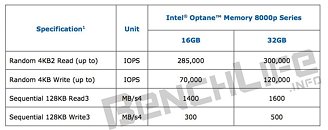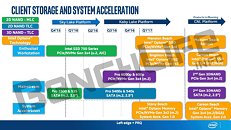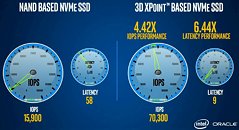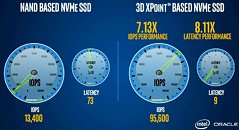Raevenlord
News Editor
- Joined
- Aug 12, 2016
- Messages
- 3,755 (1.18/day)
- Location
- Portugal
| System Name | The Ryzening |
|---|---|
| Processor | AMD Ryzen 9 5900X |
| Motherboard | MSI X570 MAG TOMAHAWK |
| Cooling | Lian Li Galahad 360mm AIO |
| Memory | 32 GB G.Skill Trident Z F4-3733 (4x 8 GB) |
| Video Card(s) | Gigabyte RTX 3070 Ti |
| Storage | Boot: Transcend MTE220S 2TB, Kintson A2000 1TB, Seagate Firewolf Pro 14 TB |
| Display(s) | Acer Nitro VG270UP (1440p 144 Hz IPS) |
| Case | Lian Li O11DX Dynamic White |
| Audio Device(s) | iFi Audio Zen DAC |
| Power Supply | Seasonic Focus+ 750 W |
| Mouse | Cooler Master Masterkeys Lite L |
| Keyboard | Cooler Master Masterkeys Lite L |
| Software | Windows 10 x64 |
The Intel-Micron joint collaboration in the development of what is promised to be the next step in storage technology is inching ever closer to reality. According to Bench Life, which published a leaked specifications list for the upcoming Intel Optane Memory products, the first application for consumer-grade 3D XPoint technology straddles the line between an SSD and system RAM. Intel calls it a "System Accelerator" solution, and it's meant to operate as an intermediate caching solution between a system's RAM and storage. Codenamed "Stony Beach", Intel's 8000p (and entire 3D XPoint-based products) support is still up in the air, but it's expected that only Kaby Lake and subsequent platforms will be compatible with the technology - which, if true, is sure to limit the product's market penetration.
The consumer products will initially sport capacities of either 16GB or 32GB, leveraging the NVMe protocol at PCIe Gen 3.0 x2 bandwidth in the M.2 form-factor. Mirroring NAND technology, the greater capacity solution will sport the highest performance: with the 16GB part coming in at 1400 MB/s read and 300 MB/s write speeds, against the 32 GB's 1600 MB/s and 400 MB/s, respectively. We see similar results in regards to IOPS, with the 16GB solution offering up to 285,000 read and 70,000 write operations per second, against the 32 GB's solution respective 300,000 read and 120,000 write. As usual with new technologies, expect all these metrics to only go up in time.


This in itself isn't much to talk about - the latest consumer-grade NAND-based SSD solutions already sport read and write speeds comparable to these Intel Optane drives (Samsung's 960 EVO springs to mind). That said, a product's performance can't be solely appraised by the way it looks on paper. As it is, the exact testing conditions that originated these performance ratings are unknown. More specifically, the metrics where 3D XPoint is supposed to excel versus NAND: latency access times, and speed at lower queue depths. And of course, one should not forget the lack of information on what amounts to the leading metric towards general consumer adoption: pricing.
True SSD-class products based on 3D XPoint are expected slightly after Intel's 8000p series, at the very end of 4Q 2016, and 1Q 2017, under the codenames "Mansion Beach" and "Brighton Beach" respectively. Details are close to nonexistent on these products at this time, save for the usage of the NVMe protocol and M.2 form-factor.


View at TechPowerUp Main Site
The consumer products will initially sport capacities of either 16GB or 32GB, leveraging the NVMe protocol at PCIe Gen 3.0 x2 bandwidth in the M.2 form-factor. Mirroring NAND technology, the greater capacity solution will sport the highest performance: with the 16GB part coming in at 1400 MB/s read and 300 MB/s write speeds, against the 32 GB's 1600 MB/s and 400 MB/s, respectively. We see similar results in regards to IOPS, with the 16GB solution offering up to 285,000 read and 70,000 write operations per second, against the 32 GB's solution respective 300,000 read and 120,000 write. As usual with new technologies, expect all these metrics to only go up in time.


This in itself isn't much to talk about - the latest consumer-grade NAND-based SSD solutions already sport read and write speeds comparable to these Intel Optane drives (Samsung's 960 EVO springs to mind). That said, a product's performance can't be solely appraised by the way it looks on paper. As it is, the exact testing conditions that originated these performance ratings are unknown. More specifically, the metrics where 3D XPoint is supposed to excel versus NAND: latency access times, and speed at lower queue depths. And of course, one should not forget the lack of information on what amounts to the leading metric towards general consumer adoption: pricing.
True SSD-class products based on 3D XPoint are expected slightly after Intel's 8000p series, at the very end of 4Q 2016, and 1Q 2017, under the codenames "Mansion Beach" and "Brighton Beach" respectively. Details are close to nonexistent on these products at this time, save for the usage of the NVMe protocol and M.2 form-factor.


View at TechPowerUp Main Site
Last edited:









